SLR Cameras and Lenses |
Previous  Next Next |
Last Updated: April 26, 2008
Photography and Mozart
Don't get too hung up about the camera equipment. Photography is about taking pictures. I've seen some comments in discussion forums where people were consumed by purchasing the best possible equipment. Someone said that it was like asking, "Which piano should I buy so that I can play like Mozart?" I had to laugh. An experienced photographer may take better photos with a $200 point and shoot camera than a novice photographer with $5,000 of equipment. To illustrate this point, see Wilson Tsoi's world class photos taken with an outdated, 7 megapixel, $200 Canon A620 point and shoot camera.
SLR Cameras

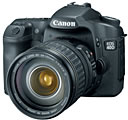
A SLR (Single Lens Reflex) camera is easy to spot because of the detachable lens. SLR cameras will give you better pictures across a wider range of conditions than point and shoot cameras. The sole reason I bought a SLR camera was to capture facial expressions that I just couldn't get with a point and shoot camera. The purchase price was a lot easier to justify after seeing the fantastic photos of the kids. I could zoom in faster, take a shot instantly, blur the background, add a fill flash and come out with a sharper looking image than any point and shoot camera. Not everyone understands the technical jargon of why one lens is better than the other, but everyone can appreciate a great photo.
Camera Brand Names
Canon and Nikon are the only two brands I recommend for SLR cameras. The other brands just don’t have the quality or choice of lenses. Both Canon and Nikon have comparable lenses and cameras at comparable prices.
My perfect camera would be a Nikon camera body with a Canon camera sensor and Canon lenses. I love how the Nikon camera body fits in my hand and how little effort it takes to change a setting. Canon cameras require too much finger/thumb movement or require two hands. The buttons are at right angles to each other instead of on a curve. I love the low noise Canon sensor for ISO 800 and 1600. It has really opened the door to natural light photography. I also love the optics and the large aperture of the Canon "L" series lenses. It's hard to go wrong with either Nikon or Canon.
Ken Rockwell has an interesting article on Nikon v. Canon cameras. He's a big Nikon fan. On August 2, 2007, he wrote how he loved the $2,500 Canon 5D for wide angle shots and either the Nikon D40 or Nikon D200 for fun and photojournalism.
Camera Features
Ken Rockwell highly recommends cameras that have dedicated buttons for:
- exposure mode (Nikon: P, S, A, M Canon: P, Tv, Av, M)
- shutter speed
- aperture
- autofocus (continuous/single, auto/manual)
- autofocus sensor (all, one, dynamic)
- single shot/continuous shooting
- ISO
- white balance
- file format (JPG, RAW)
- file size (basic, normal, fine)
- playback
- delete photo
- format memory card
He said a camera should not get in the way of taking photos. Changing a setting in a menu takes time whereas a camera button and/or dial combination takes fractions of a second. He demonstrated this on a trip to Maui, Hawaii. Ken adjusted his camera and took photos as he crossed the street in front of a moving taxi. He had enough time to take the photos only because the camera had dedicated buttons for the above features. Read what he said on December 10 at the old Lanhaina Courthouse.
Lens Brand Names
In general, Canon makes the best lenses for Canon cameras. Nikon makes the best lenses for Nikon cameras. Sigma and Tamron offer quality lenses for less money, but there are complaints on the forums at DPReview.com about quality control (QC) issues. Some lenses don't focus like they should, the photo appears soft (slightly out of focus) around the edges, or a particular lens may add a slight yellow tint. Some Sigma and Tamron models are fantastic while others are horrible. Granted, it takes a trained eye to see this. Quantaray and Vivitar lenses are substandard.
It's More About the Lens Than the Camera
Plan on selling the camera body every couple of years, but keeping the lenses. It makes the next camera $100-$300 less expensive by purchasing the body only and not the body and a lens together. The sale price of the old camera will also help offset the price of the new camera. Cameras will come and go, but the lenses can last for decades. Canon and Nikon have the widest range of lenses compared to any other SLR camera manufacturer like Fuji, Olympus, Pentax, Samsung or Sony. I don't care how wonderful one camera performs made by these other manufacturers. They don't have a large variety of other lenses. That's why I only recommend Canon and Nikon.
For starting out, buy the lens that comes with the camera. For beginners, it will work for 95% of the photos. Find out if photography is worth investing in another lens.
Canon has more high speed autofocus lenses than Nikon. The high speed autofocus lenses focus almost instantaneously which is better for sports, animals, and children. The more you photograph fast moving subjects, then the more you will appreciate fast focus lenses. Part of the lens model number will state if it's fast autofocus or not. Fast autofocus for Canon is USM (Ultra Sonic Motor), for Nikon it's AF-S (Auto Focus-Silent Wave motor), and for Sigma it's HSM (Hyper Sonic Motor). High speed focus motors are also quieter than standard autofocus motors.
Buy a UV filter for the lens to protect against scratches ($25), lens cleaning solution ($7), and lens cleaning cloth ($7).
Wide Angle and Telephoto Lenses
- A 50mm lens is comparable to what the human eye sees on FILM based SLR cameras. See the crop factor section below on why this is not true for a digital camera under $2,700.
- A 28mm lens is wide angle and will still show buildings with vertical sides.
- The closer you get to a 10mm lens, the more barrel shaped the photo will become (fat in the middle, narrow at the top and bottom). It will also make buildings look like they are leaning.
- Portrait photographers us a 85mm to a 105mm telephoto lens. It allows the photographer to be 3-4 steps back from the person for a more relaxed environment while getting a close up shot.
- Sports photography requires a telephoto lens in the 200mm to 400mm range.
- Bird photography requires a telephoto lens in the 400mm to 600mm range.
Crop Factor
Most digital SLR cameras have crop factor that film based SLR cameras do not have. This turns a wide angle lens on a film camera into a normal lens on a digital camera. It turns a telephoto lens on a film camera into a super telephoto lens on a digital camera. The same lens can be used on either a film or digital camera, but images are magnified when used on a digital camera. The image sensor on a digital camera is smaller than 35mm film which causes the magnification to occur.
For example, a Nikon SLR has a 1.5 crop factor. A 35mm wide angle lens on a film based SLR camera will be multiplied by 1.5 to produce a 52.5mm image on a digital camera. It also means a 300mm lens × 1.5 crop factor = 450mm lens. A 300mm lens on a digital camera will produce the same photo as a 450mm lens on a film camera. This is a great benefit to get the more expensive 450mm lens capability for a less expensive 300mm price. While the crop factor is an added benefit for telephoto photography, it's an Achilles heel for wide angle photography. Canon has a 1.6 crop factor for cameras under $2,000 and a 1.0 or 1.3 crop factor for cameras over $2,000.
The crop factor applies to all lenses, including the lenses made for only for digital SLR cameras.
Lens Prices
Most consumer grade lenses by Canon or Nikon cost around $250-$400 each. With the exception of a 50mm lens, any lens less than $200 is going to offer relatively poor quality. The professional grade lenses start at $800, but typically are in the $1,000-$1,300 range per lens. The super telephoto lenses in the 400mm to 600mm range can go as high as $8,000 per lens. Lenses are a potential money pit. No matter how many you have, you always want another one.
Many reviews and recommendations lean toward the expensive lenses. It's true that you can never go back to an entry level or consumer grade lens again after using a $1,000 or $1,300 professional grade lens. Many photographers recommend these high priced lenses because they will last for decades and can outlive a dozen cameras. It makes the long term costs low. If you really enjoy photography and will take tens of thousands of photos over the next few decades, and can afford it, skip the consumer grade lenses and go strait to the expensive professional grade lenses. Otherwise, you are wasting your money in the long run if you buy several lenses before getting the professional grade lens.
Some people love expensive computer equipment, some love flat screen TVs with home theater surround sound, while others indulge in an expensive hobby or two. Most of these photographers spend their money on camera equipment. Pick a passion. It can always get expensive.
Lens Codes
Canon:
- AF: Auto Focus
- USM: Ultra Sonic Motor (fast, silent autofocus)
- IS: Image Stabilization
- EF: Electronic Focus - film and digital camera lens mount
- EF-S: digital camera only lens mount
Nikon:
- AF: Auto Focus (needs focus motor built into the camera which is very common)
- AF-S: Auto Focus Silent Wave motor (fast, silent autofocus - focus motor built into the lens)
- ED: Extra-Low Dispersion glass
- IF: Internal Focusing
- VR: Vibration Reduction (image stabilization)
- DX: Lens works on digital cameras only as there isn't an aperture ring
- D: Lens mount type
- G: Lens mount type
Sigma:
- DF: Dual Focus (easy to hold the lens, since the focusing ring does not rotate during auto-focus)
- HSM: High Speed Motor (fast, silent autofocus)
- DL:
- DG: film and digital camera lens mount
- DC: Digital Camera (lens does not work on film based cameras)
- EX: denotes superior build quality and optical quality
- IF: Inner Focus
- SLD: Special Low Dispersion glass
- APO: designed to minimize color aberration
- RF: Rear Focus
- OS: Optical Stabilizer
Prime and Zoom Lenses
A zoom lens is typically less expensive than owning two prime lenses (non-zooming lenses), doesn't require constant changing of lenses, requires less space and weight in a camera bag, and doesn't require the photographer to step back and forth to compose a shot. However, a zoom lens doesn't offer as clear a photo, doesn't perform as well in low light, and is typically larger than a prime lens. A zoom lens may be one and a half times the size, weight and cost of a prime lens.
Prime lenses are the best way to get professional grade or near-professional grade photos without having to pay the price of a professional grade lens. Prime lenses are also better suited for low light photography than zoom lenses.
Best Low Light Lenses Under $450
Besides low light capability, these lenses will produce professional or near-profession grade photos.
| Canon: | 35mm f/2 ($230) | 50mm f/1.4 ($315) | 60mm f/2.8 macro ($375) | 85mm f/1.8 ($345) | 100mm f/2 ($385) |
| Nikon: | 35mm f/2 ($315) | 50mm f/1.4 ($285) | 60mm f/2.8 macro ($380) | 85mm f/1.8 ($400) | 105mm f/2.8 ($750) |
Best Zoom Lenses Under $400
There aren't any. Anything under $200 appears to be substandard. No one seems to recommend lenses in the $200-$400 range. There are very few in the $400-$800 range. Everyone is happy with lenses in the $800-$1,600 range.
Small Focal Lengths for Wide Angle Lenses Make a Huge Difference
There is a huge difference between 17mm and 12mm. There is also a huge difference between 12mm and 10mm. However, there is only a small difference between 200mm and 300mm. How can that be? I'm not sure. Perhaps it's more of perception than mathematics. The quality of the photos below is awful, but you get the idea.
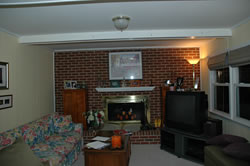 |
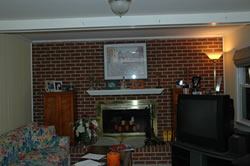 |
Do you see why photographers think 24mm is a bit cramped compared to 18mm? |
| 18mm | 24mm | |
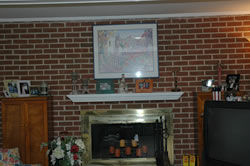 |
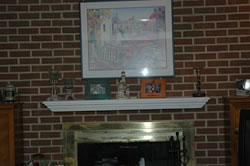 |
35mm is close to what we see in focus. Because of the crop factor, 35mm on a digital camera is close to 50-55mm on a film camera. |
| 35mm | 50mm | |
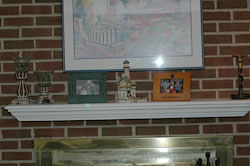 |
 |
70mm is 70mm no matter if it's a digital-only lens or a film/digital lens. The slight difference is probably due to not repositioning the camera due to lens length difference. There is not a 1.5x crop factor shown here. |
| 70mm (digital-only lens) | 70mm (film/digital lens) | |
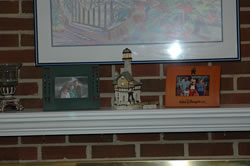 |
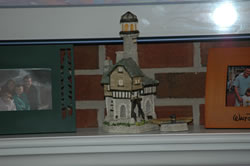 |
There is a noticeable difference between 100mm and 200mm. The center house is about 33% of the photo height at 100mm and about 66% of the photo height at 200mm. |
| 100mm | 200mm | |
 |
There is a smaller difference between 200mm and 300mm. The house is about 100% of the photo height at 300mm. | |
| 300mm |
Here are some examples of 10mm, 12mm, 17mm, and 20mm shots. There really is a huge difference.
List of Available Lenses Under $5,000
Here is a list (web page, Excel) of available lenses with prices for Canon and Nikon SLR cameras. The Excel version can be filtered and resorted and contains links to get the most current price. These autofocus lenses are sold online for about US$5,000 or less (excludes shipping and taxes) and are sold by four or more stores at PriceGrabber.com. Stores only stock lenses that sell. There must be something wrong with a lens if it is only sold in one store. Either the lens is not longer manufactured or another lens is better. Unfortunately, the list doesn't include a subjective quality rating to help evaluate the best lens for the least amount of money. The list is designed to let you know what is available.
Lens Reviews
Canon lenses: The Digital Picture, Lens Tests by LightRules
Canon and Nikon lenses: SLR Gear, Photo Zone, Photodo, ePhotoZine.
Nikon lenses: Bjørn Rørslett, Ken Rockwell, ByThom, Nikon Lens Reviews Link Collection.
Choosing the Right Lens
- If you have the cash and notice the quality difference between a professional grade lens (typically $800-$1,600) and a consumer grade lens (up to $300 with a few exceptions), then save money in the long run and purchase professional grade lenses.
- For starting out, many people buy one or two lenses. If you have the potential to buy three or more lenses over time, then you should think about which lenses to buy that don't duplicate what you already own. Some photographers recommend five lenses that have little over lap.
- There are different styles of photography and specialized lenses to match (sports, low light, landscapes, studio portraits, extreme close up {macro}, etc.).
- When comparing similar lenses at similar prices, look for the differences and make your purchase decision based on that. For example, a 17-55mm and 24-70mm lens are identical in almost every way, but more people will recommend the 17-55mm because of the digital crop factor. 24mm on a digital camera is not as wide as most photographers prefer. Another example is two nearly identical lenses but one has image stabilization or vibration reduction and the other does not. Is the price difference worth having or not having that feature? The same goes for a larger aperture (f/2.8 v. f/4) or the inclusion or exclusion of high speed autofocus capability.
- The latest trend for newly released lenses is to include image stabilization (IS) or vibration reduction (VR). Technology has allowed this to become more affordable and it really works well for lenses over 100mm.
Desired Lens Features for Different Events
These are suggestions to help you find a lens that matches your shooting style and what you want to photograph. Taking photos of landscapes on sunny days requires a different kind of lens than the one needed to take indoor sports events. In many of the examples below, a tripod would eliminate the need for high ISO settings and image stabilization. Conversely, high ISO settings and/or image stabilization are needed if a tripod is not used in low light conditions. That's why I put opt(ional) in many places.
| Are These Features Required? | |||||||||
| Event | High ISO(ISO 800) | FastShutterSpeed(1/500s) | TripodRequired? | LargeAperture(f/1.4 - f/2.8) | ImageStabilization | FastAutoFocus | Macro | FocalRange | Comments |
| airshow - flying | no | yes | no | no | no | yes | no | 80-400mm | Don't max out at 200mm. |
| airshow - outdoor display | no | no | no | no | no | no | no | 17-70mm | Use flash or low light lens for airplane interior. |
| birds | no | no | yes | opt | opt | opt | no | 400-600mm | |
| buildings / monuments | no | no | no | no | no | no | no | 24-70mm | Buildings tilt under 24mm. |
| candid | no | no | no | opt | no | opt | no | 17-70mm | |
| children playing | opt | yes | no | opt | no | yes | no | 24-70mm | |
| ebay items - small | no | no | opt | opt | no | no | yes | 60-135mm | min focus 15cm |
| ebay items - small | no | no | opt | opt | no | no | no | 150-300mm | min focus 1m |
| flowers | no | no | opt | yes | no | opt | yes | 60-100mm | min focus 15cm |
| flowers | no | no | opt | yes | no | opt | no | 150-300mm | min focus 1m |
| forest / woods | opt | no | opt | opt | opt | no | no | 24-135mm | Tripod with night settings or flash required. |
| group photo - posed | no | no | opt | no | no | no | no | 17-35mm | |
| indoor - no flash | yes | no | opt | yes | yes | opt | no | 24-50mm | Prime lenses have larger apertures than zoom lenses. |
| landscape | no | no | no | no | no | no | no | 17-24mm | |
| low light | opt | no | opt | yes | opt | no | no | 17-55mm | Tripod preferred to prevent blurring. |
| moon | no | no | yes | no | no | no | no | 400-600mm | |
| museum - no flash | yes | no | opt | yes | opt | opt | no | 24-50mm | Prime lenses have larger apertures than zoom lenses. |
| night | opt | no | yes | opt | no | no | no | 24-135mm | |
| portraits | no | no | opt | yes | no | opt | no | 60-135mm | |
| sports - indoor | yes | opt | opt | yes | no | yes | no | 85mm | No flash allowed, f/1.8 prime is best bet. |
| sports - outdoors | no | yes | no | opt | no | yes | no | 200-400mm | |
| sunrise / sunset | no | no | yes | yes | no | no | no | 24-135mm | |
opt=optional
Camera Bags
Most enthusiast and professional photographers own several bags. There isn't a perfect bag. Some prefer a backpack style for long walks and comfort. Some prefer a bag that opens on top with either a zipper down the middle or a flap. If you forget to zip up the bag, the camera won't fall out. Some like photo vests with lots of pockets while others prefer a belt with small cases strapped to the side. Some prefer a camera bag that doesn't look like a camera bag.
Lowepro, Tamrac, ThinkTank and Domke are some of the better, more common camera bag brand names.